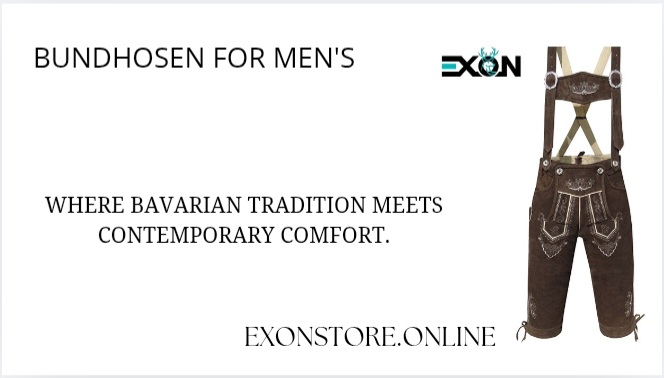The traditional attire of Bavaria has always been admired for its charm, durability, and cultural value. While lederhosen are widely known, bundhosen hold their own unique place in Bavarian fashion history.
These knee-length leather trousers, worn by men for centuries, combine practicality with cultural symbolism. Today, they stand as a stylish and traditional outfit choice for men at festivals, weddings, and cultural gatherings.
Bundhosen have evolved over time, yet they have never lost their identity. They remain an essential part of Bavarian clothing and continue to be appreciated for their craftsmanship, elegance, and historical significance.
What Are Bundhosen?
The term “bundhosen” refers to traditional leather trousers that are slightly longer than lederhosen. While lederhosen typically end above the knee, bundhosen extend just below it, giving them a more formal and modest appearance.
Like lederhosen, they are made from durable leather—commonly deerskin, goatskin, or cowhide.
Their design includes detailed embroidery, adjustable suspenders, and strong stitching, making them suitable not only for cultural events but also for everyday wear in the past.
The additional length made bundhosen practical for outdoor activities, hunting, and farm work, offering better protection and comfort.
The Origins of Bundhosen
Bundhosen, much like lederhosen, have roots in the Alpine regions of Germany and Austria.
During the 18th and 19th centuries, working men needed clothing that could endure rugged terrain and physical labor.
Leather was the perfect material, as it was tough, resistant to wear, and long-lasting.
While lederhosen became popular among younger men and laborers, bundhosen were preferred by older men and those seeking a more dignified appearance.
The longer cut made them more versatile, allowing them to be worn in both casual and formal settings.
Over time, bundhosen grew into a symbol of tradition and pride, worn during cultural festivities to honor Bavarian heritage.
Bundhosen vs. Lederhosen
Although both garments share similarities, there are key differences between bundhosen and lederhosen:
- Length – Lederhosen usually end above the knee, while bundhosen extend below the knee.
- Formality – Bundhosen are considered slightly more formal and traditional compared to the shorter lederhosen.
- Practical Use – The longer length of bundhosen made them more practical for farming, hiking, and outdoor work.
Because of these distinctions, men often choose bundhosen when they want a more modest, traditional, or formal look at cultural events.
Cultural Significance of Bundhosen
Like lederhosen, bundhosen are closely tied to Bavarian culture and traditions. They are most often worn during Oktoberfest, folk festivals, and regional celebrations.
Paired with embroidered suspenders, checkered shirts, wool socks, and traditional Bavarian shoes, bundhosen complete the authentic Alpine look.
Beyond Oktoberfest, bundhosen are also worn at weddings, cultural performances, and heritage events. Wearing them represents pride in Bavarian roots, a celebration of tradition, and a connection to generations past.
Modern Adaptations of Bundhosen
In the modern fashion world, bundhosen have undergone transformations while retaining their classic charm. Designers now experiment with colors, embroidery styles, and cuts to appeal to younger audiences.
While the traditional brown and tan leather versions remain popular, modern bundhosen can also be found in black, gray, and even more fashionable shades.
Another adaptation is in the choice of materials.
While genuine leather remains the standard for authenticity, some modern bundhosen are made using softer, lightweight leather or even leather alternatives, making them more comfortable for casual wear.
Bundhosen have also made their way into global fashion through the popularity of Oktoberfest celebrations worldwide. Men outside of Germany and Austria now wear them as a way to embrace and enjoy Bavarian culture.
Why Men Love Bundhosen
Bundhosen remain a favorite for many reasons:
- Durability – Made from high-quality leather, they last for decades if cared for properly.
- Cultural Pride – Wearing bundhosen allows men to connect with their heritage and showcase Bavarian traditions.
- Comfort – Despite their rugged appearance, bundhosen are comfortable once broken in, adapting to the wearer’s shape over time.
- Timeless Style – Bundhosen have never gone out of fashion. Their unique look stands apart from modern trousers, giving men a distinctive style.
Styling Bundhosen Today
Bundhosen are usually styled with traditional shirts—either plain white or checkered patterns in red, blue, or green.
Wool socks that reach the knees, paired with Haferlschuhe (traditional Bavarian shoes), complete the outfit. Suspenders with embroidered details add both function and charm.
For modern events, men sometimes pair bundhosen with casual T-shirts or light jackets, blending tradition with contemporary style. This flexibility makes bundhosen suitable for both cultural festivals and modern fashion settings.
Conclusion
The men’s bundhosen is more than just a pair of leather trousers; it is a piece of history, a symbol of Bavarian pride, and a timeless fashion choice.
From its origins as practical workwear to its place in today’s festivals and celebrations, bundhosen have kept their authenticity while adapting to modern trends.
Their longer cut, durability, and cultural meaning set them apart from lederhosen, making them a favored option for men who want a more traditional or formal look.
Whether worn at Oktoberfest, a wedding, or a cultural event, bundhosen continue to showcase Bavarian heritage with elegance and masculinity.
With their lasting charm and timeless appeal, bundhosen remain a proud part of men’s fashion that will never fade. They are not just trousers, but a celebration of tradition, culture, and identity.







